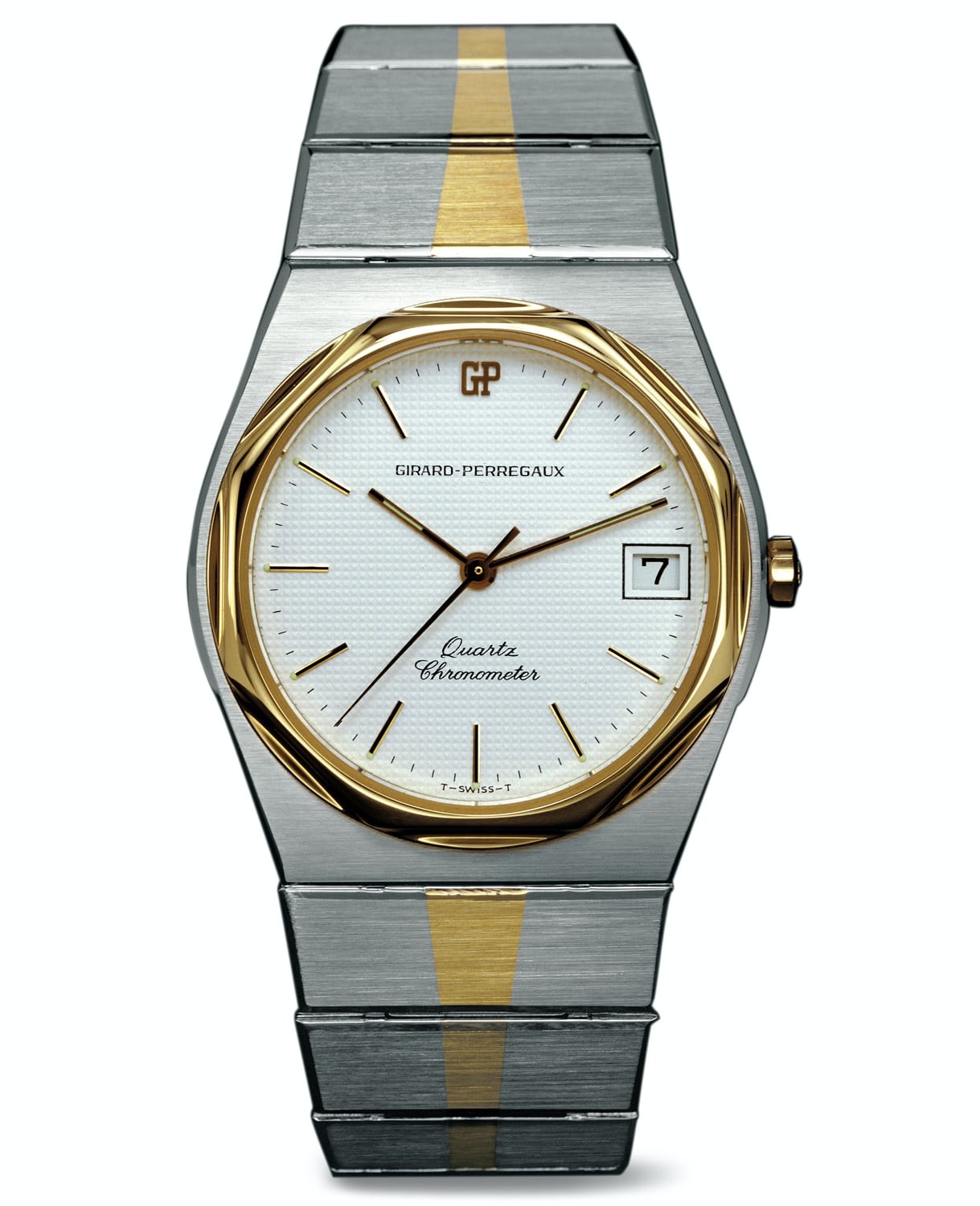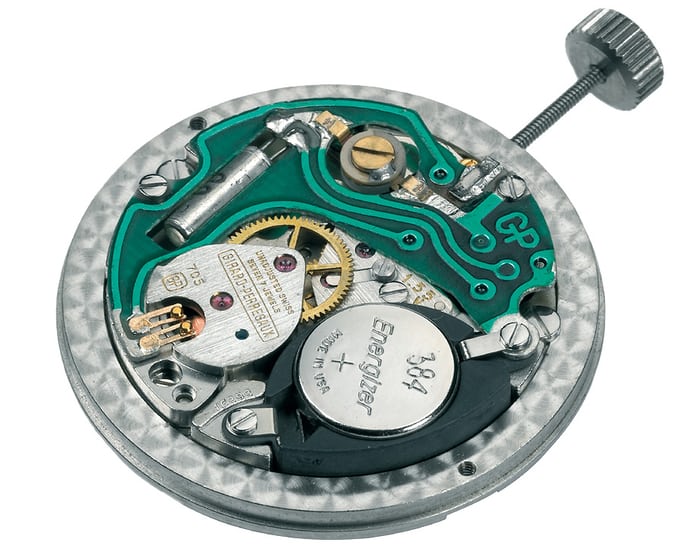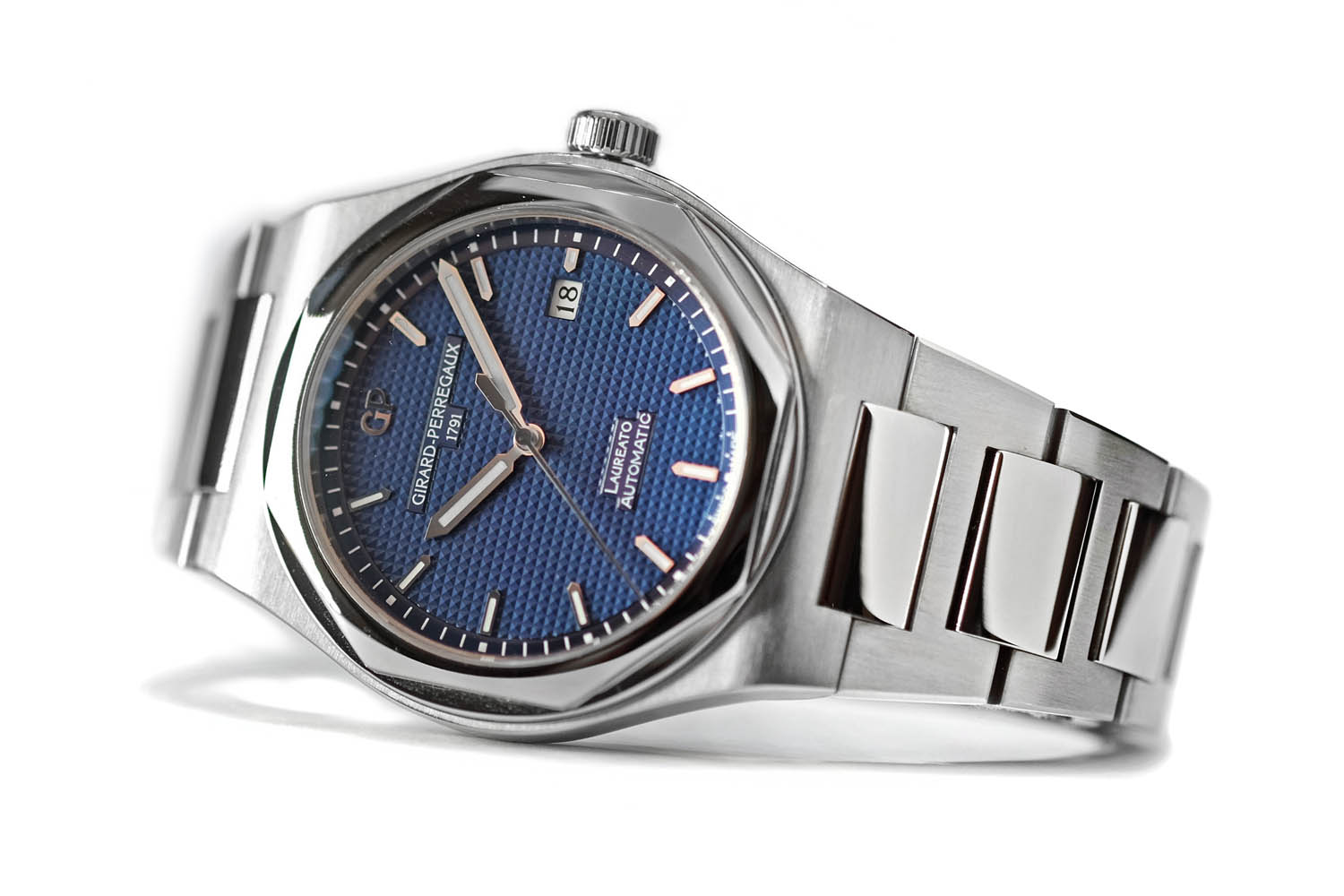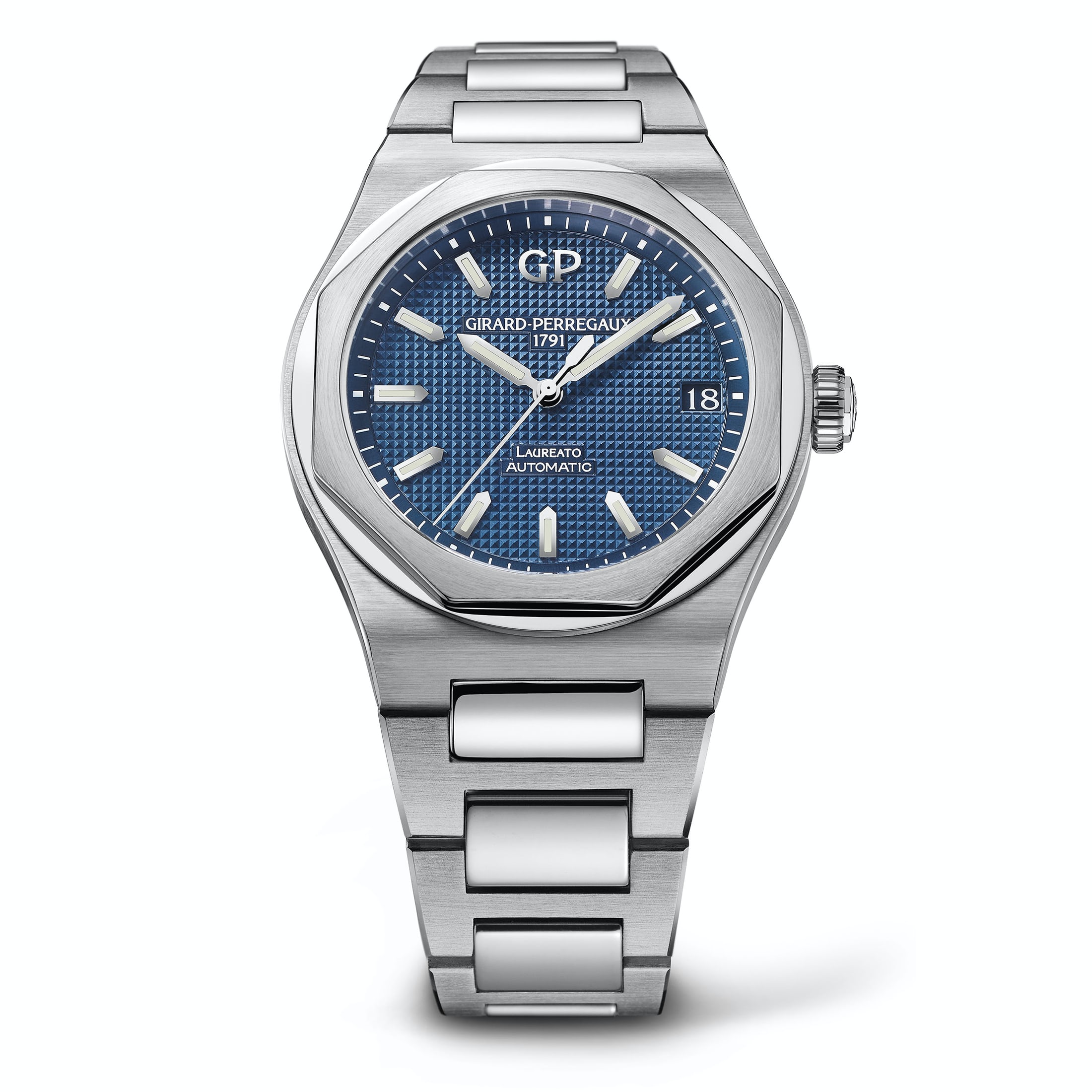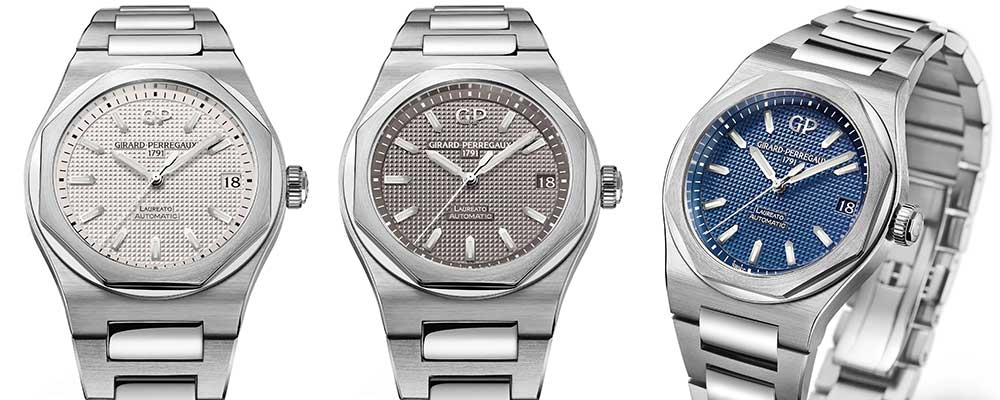This is the Girard-Perregaux Laureato 42 Automatic. And it’s something of a unicorn. By which I mean it’s a luxury steel sports watch. On an integrated steel bracelet. From a reputable brand. With decent heritage. But which the internet is not losing its mind about. As a result, it actually trades at below retail on the secondary market. Not by much mind you. Still, you can see how it might be more attractive than paying over four times retail for a competitor. But does it deliver the same bang for your buck? Let’s get into it and find out if the Girard-Perregaux Laureato 42 actually is a great buy.
A (Very) Brief History of the GP Laureato
Like all good luxury steel sports watches, the Laureato 42 traces its origins to the 1970s. 1975 to be specific. Three years after Gerald Genta and Audermars Piguet created the genre-defining Royal Oak. As I’m sure you’re already aware, Genta was also responsible for the design of the Patek Nautilus. Although that came out the year after the Laureato. As did the Vacheron Constantin 222, which was the work of a young Jorg Hysek.
- The original Girard-Perregaux Laureato from 1975.
A celebrated watch designer wasn’t behind the design of the Laureato though. Instead, Girard-Perregaux chose to work with a Milanese architect for the design. That’s not a knock mind you. It’s clear he did a fantastic job. But I do wonder if this in some way impacts collectors’ perceptions of the Laureato. The name of which was suggested by GP’s Italian distributor. It translates to the Graduate in English. Someone was a Mike Nichols/Dustin Hoffman fan it seems.
The case design is at once familiar yet unique. And very fitting for the period. There’s the combination of octagonal and round shapes for the bezel. The slim case profile. And of course, the integrated bracelet. But what sets the Laureato apart is the way the sides of the octagon slope down. And the clever use of convex and concave surfaces. It makes everything look more, well, architectural. Genta drew inspiration from old-fashioned diving helmets for his creations. GP’s architect meanwhile looked to the dome of the famed Florence Cathedral.
Quartz Power!
There’s something else that set the Laureato apart from its peers at the time though. And which may go part way to explaining why it’s not viewed in the same light today. While AP et al all opted for slim mechanical movements, GP chose to debut a new quartz movement instead. But not any old quartz movement. The new Calibre 705. An in-house developed chronometer that was progressive for its time. Something that could deliver both accuracy and reliability in a slim package.
Why, you ask?
It may surprise you to learn that GP played an important role in developing quartz movements. In 1971, the company released the GP-350. The first movement to have a quartz crystal vibrating at 32,768 Hz. The frequency that would go on to become the industry standard. At the time, its accuracy was without parallel. One minute’s error per year!
- The Girard-Perregaux Quartz Caliber 705 powering the 1975 Laureato.
Viewed in that light, the choice of quartz movement makes a lot more sense. This sleek and modern timekeeper was popular with the younger crowd it was targeting. Much like the Rolex Datejust OysterQuartz that followed two years later. And so, it was almost 20 years before GP decided to add in a mechanical movement. The new (at the time) manufacture calibre 3000. As part of this upgrade, GP redesigned the case of Laureato. It needed to be bigger to accommodate the new movement, albeit with a slimmer profile. To keep everything in proportion the bezel was also made thicker. And the links of the integrated bracelet took on the “H” shape we see on the current model.
Further iterations would follow with GP changing the case and movement again in 2003. It got even bigger – 44mm – and introduced a strip of rubber in-between the case and the bezel. Akin to the Royal Oak Offshore. But evidently it never found its mark and GP ceased production on the Laureato a short while later.
The Girard-Perregaux Laureato Anniversary Edition
After a long hiatus, it seems GP was ready to reintroduce the world to the Laureato once again. But the brand wasn’t sure how the market would receive it. So, it devised a clever ploy. The year 2016 marked GP’s 225th anniversary (!!). The perfect opportunity to debut several special models to mark the occasion. Among them was the Laureato Ref 81000. A limited edition of 225 pieces in each of two dial colours (blue and silver).
This new model did not pick up where things left off back in the mid-2000s with the EVO3 though. Instead it marked a welcome and refreshing return to something resembling the original. Smaller case (41mm). Slimmer profile (10.1mm). And attractive if plain dials with a lovely clous de Paris (hobnail) pattern. This was much more in the vein of the luxury steel sports watch we’re used to.
- The limited edition Girard Perregaux Laureato Automatic for the 225th Anniversary.
Inside was the GP caliber 3300-0030. A decent, in-house self-winding movement delivering a 46 hour power reserve. Although at 25.6mm in diameter it must have been swimming in the 41mm case. There was also the issue of price. At US$14,300, this limited edition Laureato was venturing into Royal Oak territory. (At that time, at least!) A bold bid by GP but one that the watch itself couldn’t quite back up. There was also the small matter of the GP 1966 40mm Automatic in steel.
GP had debuted that watch a year earlier. A clean and attractive dress watch on a leather strap or matching bracelet. So, why does that matter to the Laureato? Well, the 1966 used the exact same movement and offered the same functionality. But it cost US$8,200 on a bracelet. There’s no doubt the case of the Laureato was more complex. And it was a special edition. But watch enthusiasts still had a hard time swallowing the $6k price difference.
This wasn’t a crash and burn situation so to speak. Far from it as the model definitely got people’s attention. But there were lessons to learn. And credit to GP for paying attention to the feedback. Rather than mothballing the Laureato again, they went back to the drawing board.
The New Girard-Perregaux Laureato 42 Automatic
The next year, GP launched the Laureato as a full collection. Among the new models was the Laureato 42 Automatic. A subtle evolution of the anniversary edition. The case gets a little bigger at 42mm. And was available in steel, titanium and titanium/pink gold. Although GP later changed to steel only. And added a full black ceramic version. It also got a new movement in the form of the upgraded GP01800-0008 automatic. Not only did it do a better job of filling the case, but it also increased the power reserve to 54 hours.
The biggest change though was the price. The full steel model came in at a more palatable US$11,000. Plus, there was also a leather strap option for US$10,300. GP has since reverted to bracelet only for the Laureato 42 it seems. Again, it wasn’t a knock out success but there’s no question the Laureato 42 became a lot more compelling. The finishing of the case is top shelf. The quality of the bracelet is excellent. Although there is still no micro adjustment, which is a bit of a let down. And the reality is, it’s still accessible as a practical, luxury steel steel sports watch.
Price & Availability
As mentioned above, the retail price of the Girard-Perregaux Laureato 42 is US$11,000. That’s on a matching steel bracelet. Finding one shouldn’t be too hard either. GP isn’t exactly giving them away but don’t expect the Rolex waitlist treatment. Likewise, a quick search on the secondary market will yield plenty of results. Most offered at 10 – 15%+ below retail. There are also some cool limited-edition options out there too. Like this Arabic dial from our retail partners WatchBox. (Affiliate link.)
Is the Laureato 42 A Great Buy?
In the eyes of collectors, the Laureato 42 suffers from something of an identity crisis. As does GP as a whole for that matter. Patek and AP and the like tend to keep their classic luxury steel sports watches very uniform. For the most part, there is a clear thread carried through from each model’s origin until today. GP meanwhile has opted to go more for the Hublot approach. Meaning lots of variation on the same theme. Hi-tech case materials. And a hearty helping of ‘special’ editions. It doesn’t help as well that GP couldn’t seem to get the formula right in the past. Meaning lots of evolutions of the collection over the years. Not all of it pretty.
There’s nothing wrong with a bit of variety, of course. And there’s nothing that says GP has to follow the traditional blueprint for integrated steel sports watches from the ’70s. That said, it does mean the Laureato 42 will never get the title of a collectible watch. Does that matter? Depends on what you’re looking for, I suppose. Is it a great watch? With an interesting and well-executed design? From an integrated manufacturer with serious history and a top reputation for quality? The answer is yes, yes and yes!
A lot of people still sleep on GP because the brand has not marketed itself as well as its competitors. Its pricing has sometimes – ok, a lot of the time – been a little out of kilter. And it’s made some made poor decisions in the past about product mix and design. Regardless, they still know how to make high-quality watches. And well-regarded in-house movements.
So, let’s put the mixed (troubled?) past of the Laureato aside for the moment. Instead, we’ll judge it only on its merits today. (What a novel concept!) What you get is a stylish, well-constructed luxury steel sports. With a manufacture movement. And an integrated steel bracelet. For around US$10k. Assuming you buy on the secondary market. Or get a discount from your AD. And make no mistake, you can actually buy this watch. There are no ridiculous waiting lists. Or insane premium pricing. Those things alone are worth giving the Laureato a second look. Aside from the fact that it’s also a pretty decent watch in its own right.
Technical Specifications: Girard-Perregaux Laureato 42
- Case: 42mm x 10.9mm – stainless steel – slightly domed sapphire crystal with anti reflective coating – water resistant 100 metres (10 ATM, 10 bar).
- Dial: blue, silver or black – Clous de Paris pattern – baton markers – hands and indices with lume – brushed fixed bezel.
- Movement: GP01800-0008 – in-house – automatic – 28,800 vph (4 Hz) – min. power reserve of 54 hours – hours, minutes, seconds and date.
- Bracelet: Integrated steel bracelet – alternating polished and satin-finished surfaces – steel triple-folding buckle – no micro adjustment.
- Price: US$11,300
This article by TheWatchLounge has been sponsored by our partner WatchBox.
